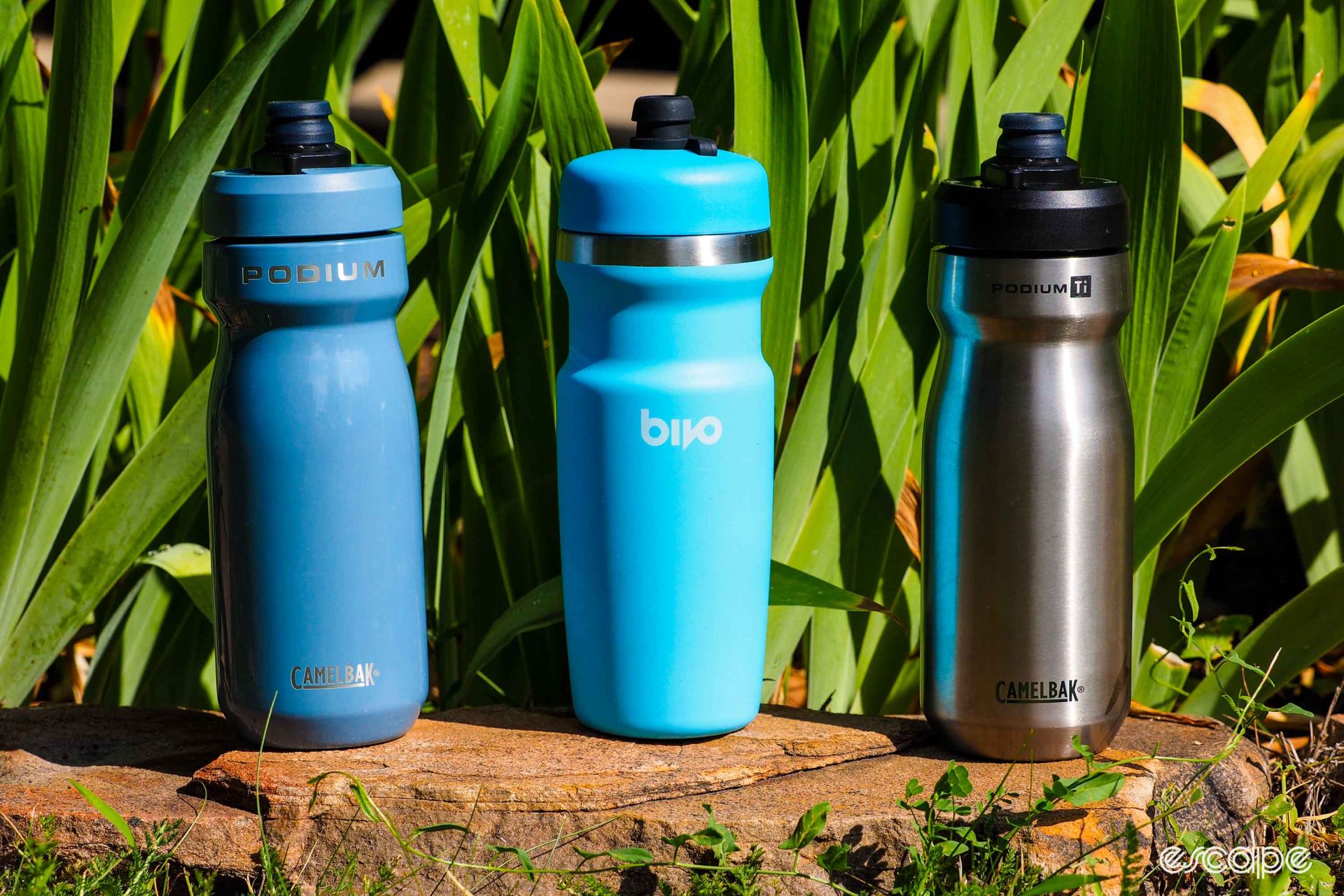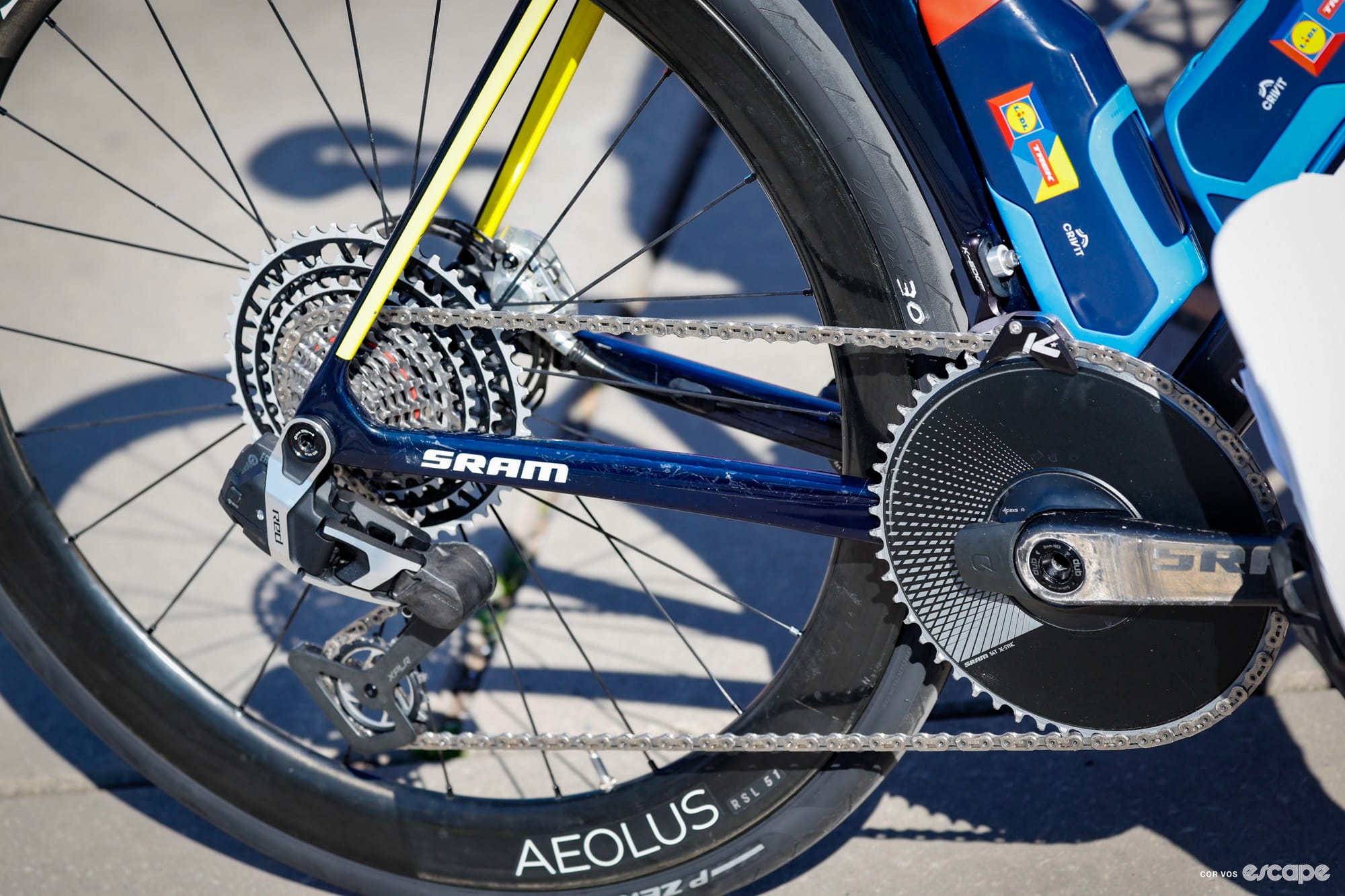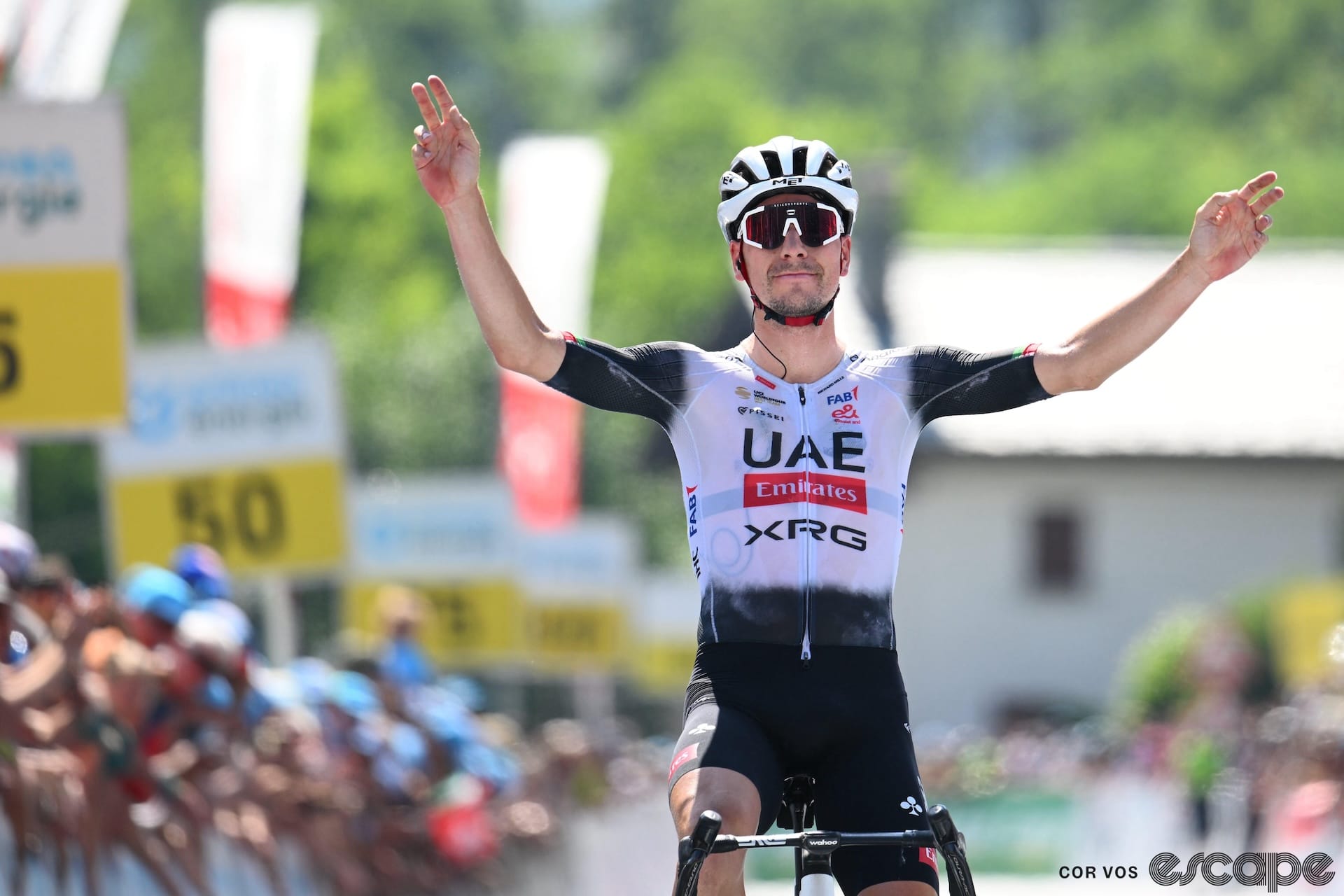There’s a sudden wealth of options on the market when it comes to insulated water bottles to help keep your drinks – and your bodies – a little cooler in summer heat. But with so many options out there, which is the best one?
I gathered up a whole bunch of bottles – insulated and otherwise – and some thermometers, and enlisted the help of good ol’ Mother Nature to help me answer the question. You might not be entirely surprised by the answer, but you might be surprised at just how far ahead of the pack the frontrunners are.
It’s gettin’ hot in here
Chances are you’ve noticed your summers have gotten both longer and hotter – and you’re not imagining things. This summer has been the hottest since modern society started keeping scientifically accurate records in 1940, and all signs point to future summers getting hotter still, which means we’re spending more time riding in intense heat on average than we used to. Even if it’s not quite a safety risk wherever you are, getting overheated isn’t great for performance, nor does it make for a fun day out in general.
Insulated bottles have long been a staple piece of kit as a way to pour something other than steaming-hot liquids down our throats during a summertime ride. Double-walled plastic bottles with some sort of foam liners have been the norm, but some brands have recently upped the ante with vacuum-insulated, double-walled metal construction borrowed from the outdoor world. Bivo was arguably the first to really popularize the concept for cycling with its stainless steel Trio model that was introduced last year, but now CamelBak has come out with two Podium insulated models, one made of stainless steel and the other made of titanium.
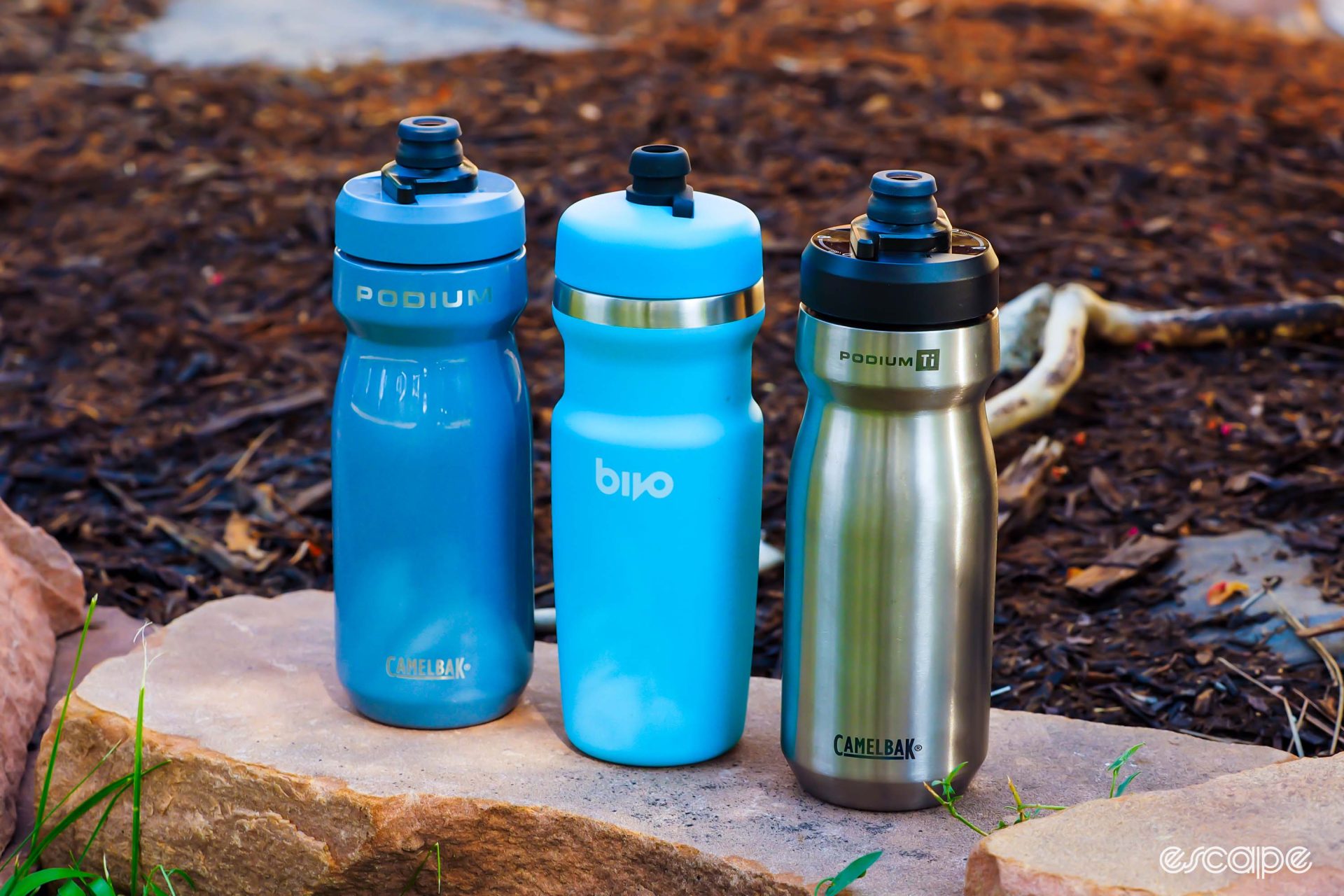
Bivo offers the Trio in two sizes: one with a 500 mL (17 oz) official capacity, and a larger one rated at 620 mL (21 oz). The small Bivo Trio Mini is available in three colors, but the bigger version is sold in five. The Podium insulated stainless bottle comes in six colors and a 530 mL (18 oz) or 650 mL (22 oz) size, while the Podium insulated titanium bottle is only offered in the small 530 mL (18 oz) capacity and a raw brushed finish.
Fair warning: none of these options is remotely inexpensive. Bivo’s bottles are US$39-49, the CamelBak Podium stainless steel bottle is US$35-40, and the Podium Ti is a whopping US$100. (Bivo ships internationally based on US currency, and is currently finalizing official European distribution. Regional pricing there hasn’t yet been set, and other markets are still pending. CamelBak’s international pricing is also still pending.)
But if you adhere to the philosophy that you should invest in things that are not only very durable and long-lasting, but also excel at their stated tasks, I’d say there’s a value argument to be made here since the metal construction won’t degrade over time like plastic will, nor will it impart a funky chemical taste to your water. Plus, cold water on a hot day makes everyone happy, and it’s hard to put a price tag on happiness, no?
Chill out
To see which bottle comes out on top, I picked a particularly hot and sunny Colorado summer day, filled each 500mL bottle with the same amount of ice cubes and water, placed them on a concrete slab blasted in direct sunlight, and then periodically checked the fluid temperature with a food thermometer and the temperature of the concrete slab with a non-contact laser thermometer.
You know what? All three of these bottles did remarkably well.
At the beginning of the test, the ambient temperature was 29°C (84°F) , and thanks to that intense high-altitude sunlight, the slab temperature was already 41°C (106°F) despite it only being 10:00am. Water temperature for all three bottles was a consistent 0°C (32°F).
After two hours, ambient temperature had climbed to 32°C (90°F) and the slab was an uncomfortable-to-the-touch 52°C (126°F), but the water in all three bottles was sitting pretty at a chilly 1°C (34°F). It wasn’t until 3 1/2 hours had passed (36°C / 97°F ambient temperature, 52°C / 126°F slab temperature) that I started to see a little separation. The water in the Bivo Trio and CamelBak Podium Ti had crept up to 3°C (37°F), but the Podium Stainless was sitting at 1°C (34°F) – still barely above freezing.
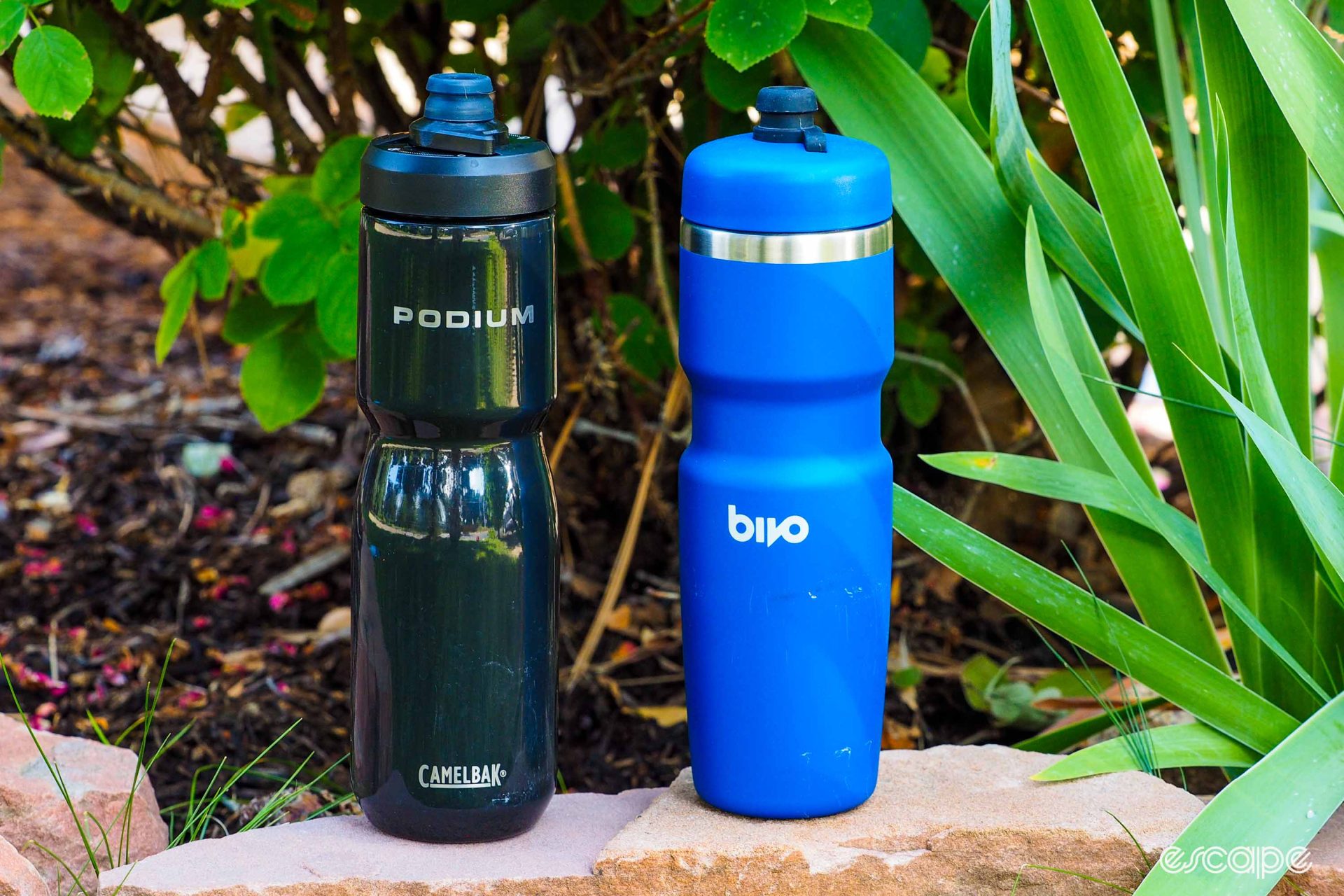
After another 2 1/2 hours (30°C / 86°F ambient temperature, 40°C / 104°F slab temperature), the water in the Podium Ti was the warmest at 7°C (45°F), while the Bivo Trio was second-best at 5°C (41°F) – still quite cold in both cases, I should point out. But the Podium Stainless? Hot damn, it was still holding strong at 1°C (34°F).
I took final readings six hours after I’d started (28°C / 82°F ambient temperature, 34°C / 93°F slab temperature). Water temps had inched upward again, though not by much. The water in the Podium Ti was now at 10°C (50°F), the Bivo Trio water was 7°C (45°F), and the fluid inside the Podium Stainless was (incredibly) still just 2°C (36°F).
Long story short: although they’re not quite equal in this respect, all three of these vacuum-insulated bottles do a fantastic job of keeping their contents nice and chilly.
What about other kinds of bottles?
Good question – and I have answers.
In addition to those three double-walled metal bottles, I tested three others: an insulated CamelBak Podium Chill double-walled plastic bottle, a non-insulated Bivo single-walled stainless steel one, and a non-insulated Elite Fly single-walled plastic bottle.
Not surprisingly, none of these did nearly as well.
After just two hours – when air temps were 32°C (90°F) – the water in the Podium Chill bottle was already a lukewarm 25°C (77°F), while the water in the Elite Fly was a toasty 30°C (86°F). But the uninsulated Bivo? That water was downright hot at a whopping 35°C (95°F).
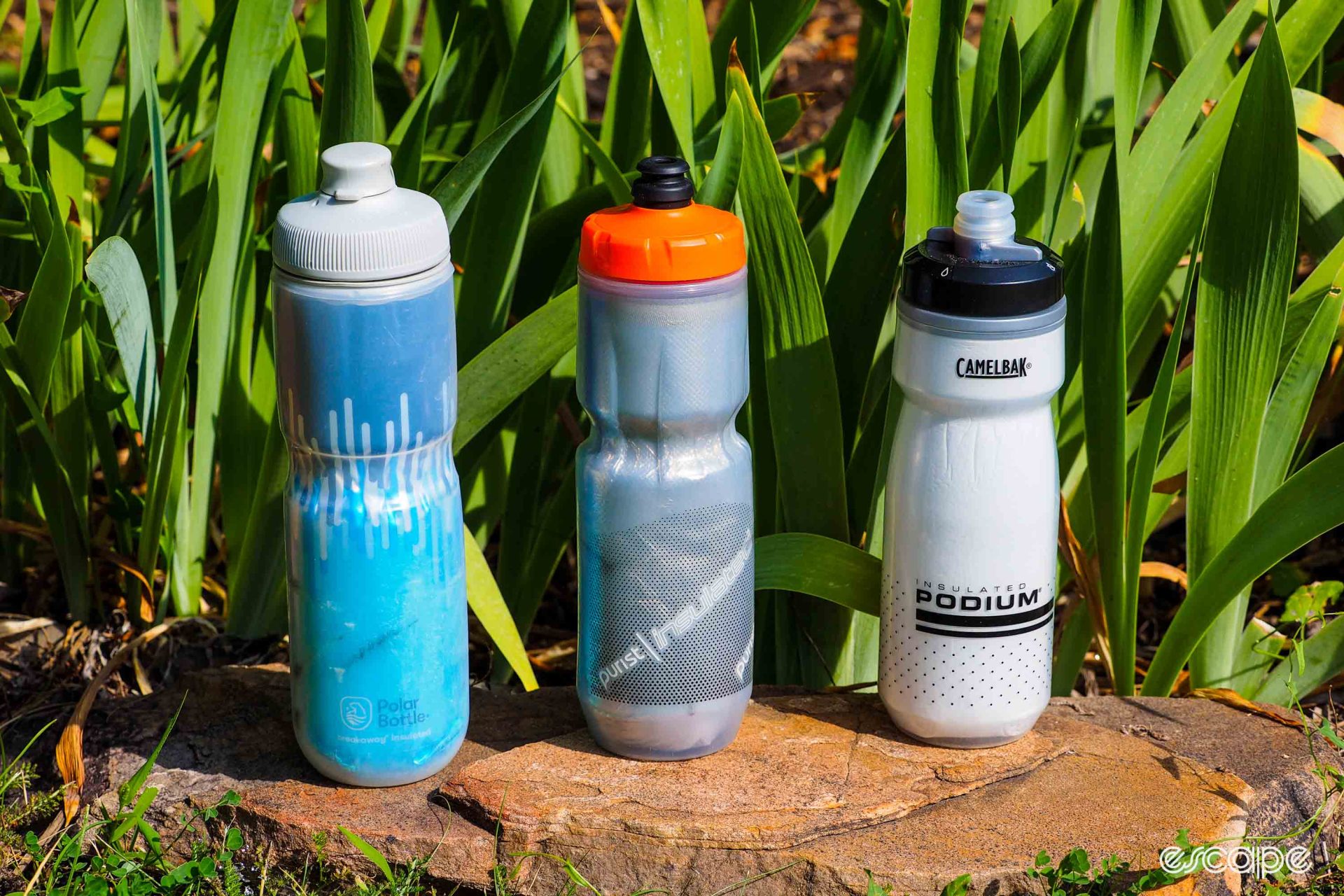
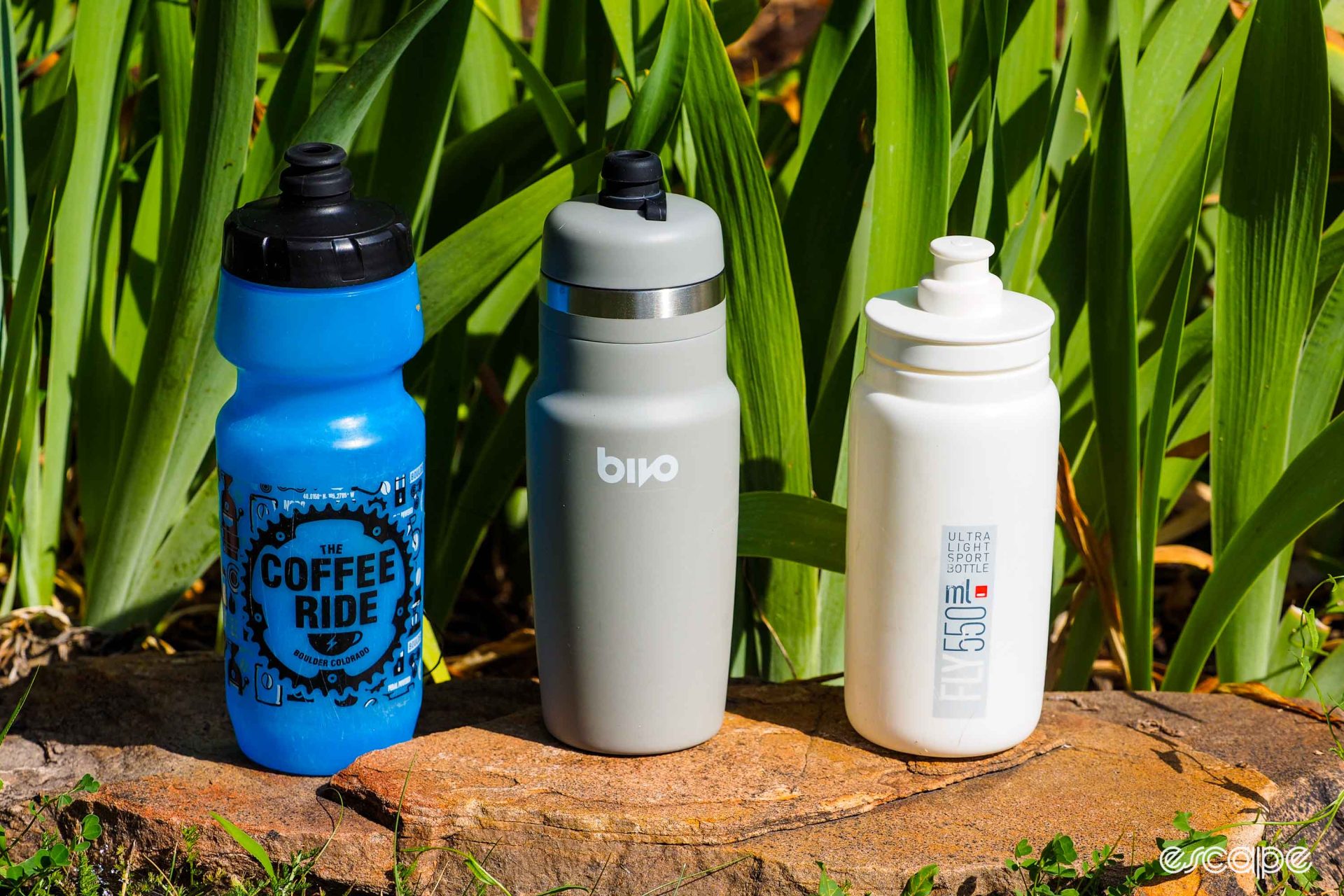
I should point out that I wouldn’t be super stoked to drink straight water out of any of these bottles in those sorts of conditions. The water in the Podium Chill bottle was at least cooler than ambient so it was somewhat refreshing, but it still had a plasticky aftertaste. And while the water in the Elite Fly bottle was only somewhat warmer, there was still that chemical ickiness (something a Specialized Purist bottle with its vapor-deposited silica coating would temper somewhat). I’ve made it well known at this point how much I love Bivo bottles for their taste-free stainless construction, but steel unfortunately transfers heat more than plastic.
In summary, hot water is better than no water when it comes to cooling down your body, but if given the option, I still prefer mine to be cold, so it’s back to one of the double-walled metal bottles for me.
Much ado about nothing
Ever wonder why metal bottles like these do such a good job of maintaining the temperature of their contents? It’s nothing, really – quite literally. More specifically, the key is the vacuum that separates the fluid inside from the outside environment.
Put in very simple terms, molecules vibrate in proportion to temperature: the hotter they are, the more they wiggle. And if you put molecules that are vibrating a lot next to ones that aren’t vibrating quite as much, some of that energy is transferred to the slower-moving molecules.
Single-walled bottles aren’t able to keep the energy of the molecules inside of them (the water) separated very well from the molecules on the outside (the surrounding air) because the molecules of the plastic can still pass that energy along. And the molecules of metal bottles are especially good at conducting that energy, which is why the water inside of them gets so warm when it’s hot outside. Moving to a double-walled construction with an insulating layer in the middle helps since insulation slows down the rate of heat transfer, but it only makes it harder for that energy to transfer, not impossible.
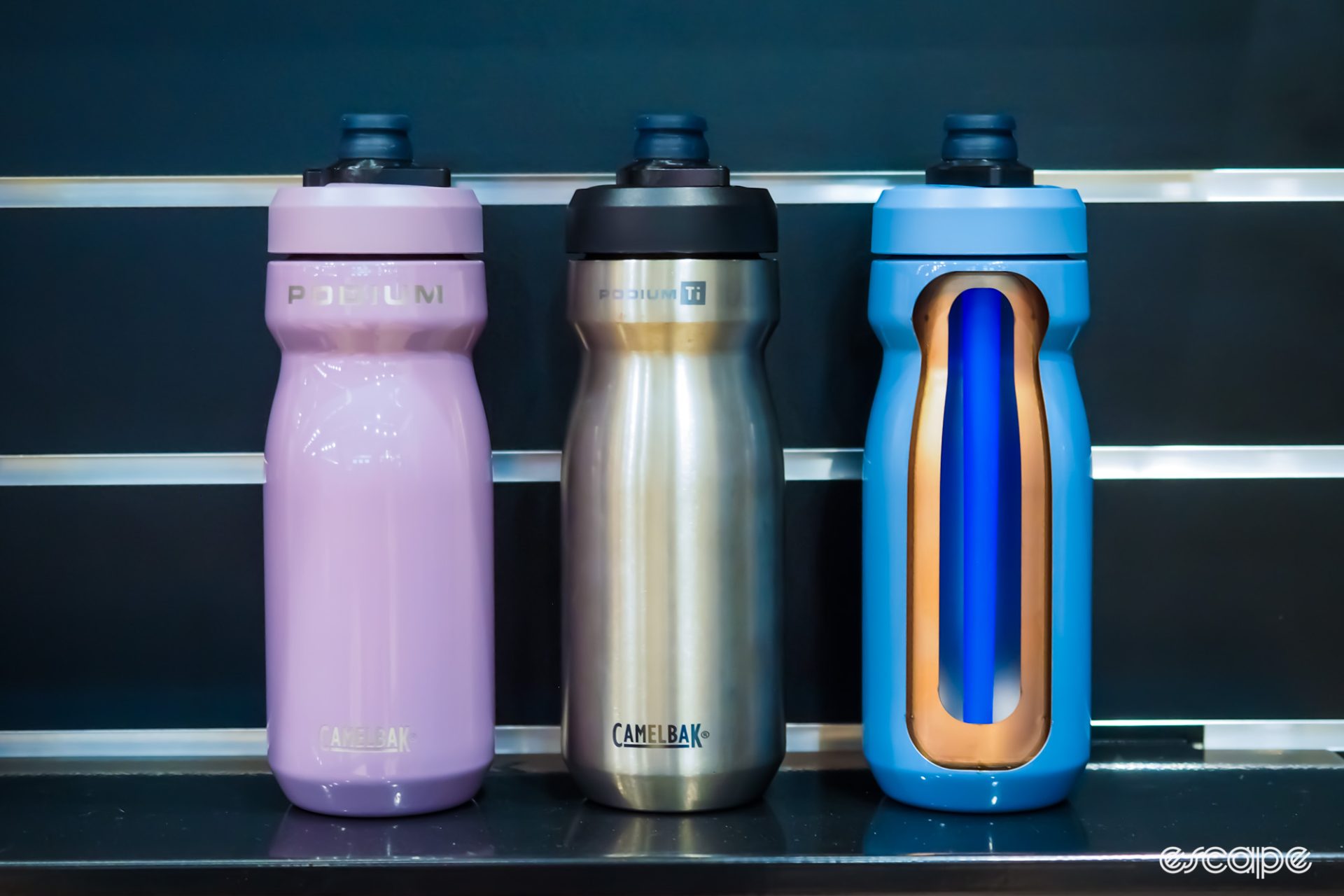
However, when you separate the fluid and the surrounding air with a vacuum, you’re completely removing any way for that thermal energy to transfer from one body to the other. Each individual wall will get as cold or hot as whatever’s next to it, but those vibrations can’t cross the gap to the other side. If you’ve done a good job of sucking all the air out of the insulating chamber, the fast-wiggling molecules stay on the outside and the slower-moving ones stay inside, and never shall the two meet. And because plastic is always slightly permeable to air, metal is the way to go any time you’re talking about maintaining a vacuum over time.
Mo’ water is mo’ better
Determining the best water bottle for hot weather isn’t just about how well they insulate. Realistically speaking, all three of the double-walled metal bottles keep drinks cold well beyond when you’d actually be finished drinking the contents, so while the Podium Stainless was clearly better than the other two in that respect, I don’t consider it a genuine advantage in the real world since any of the three bottles are likely to be empty well before the contents heat up.
What’s also important is how much fluid the bottles hold, and how quickly you can get that fluid into your body.
One big downside to any double-walled metal bottle is capacity. There needs to be separation between the two walls by definition for the vacuum to work, and that eats into volume. I’ve already covered the official specs above, but that only tells part of the story.
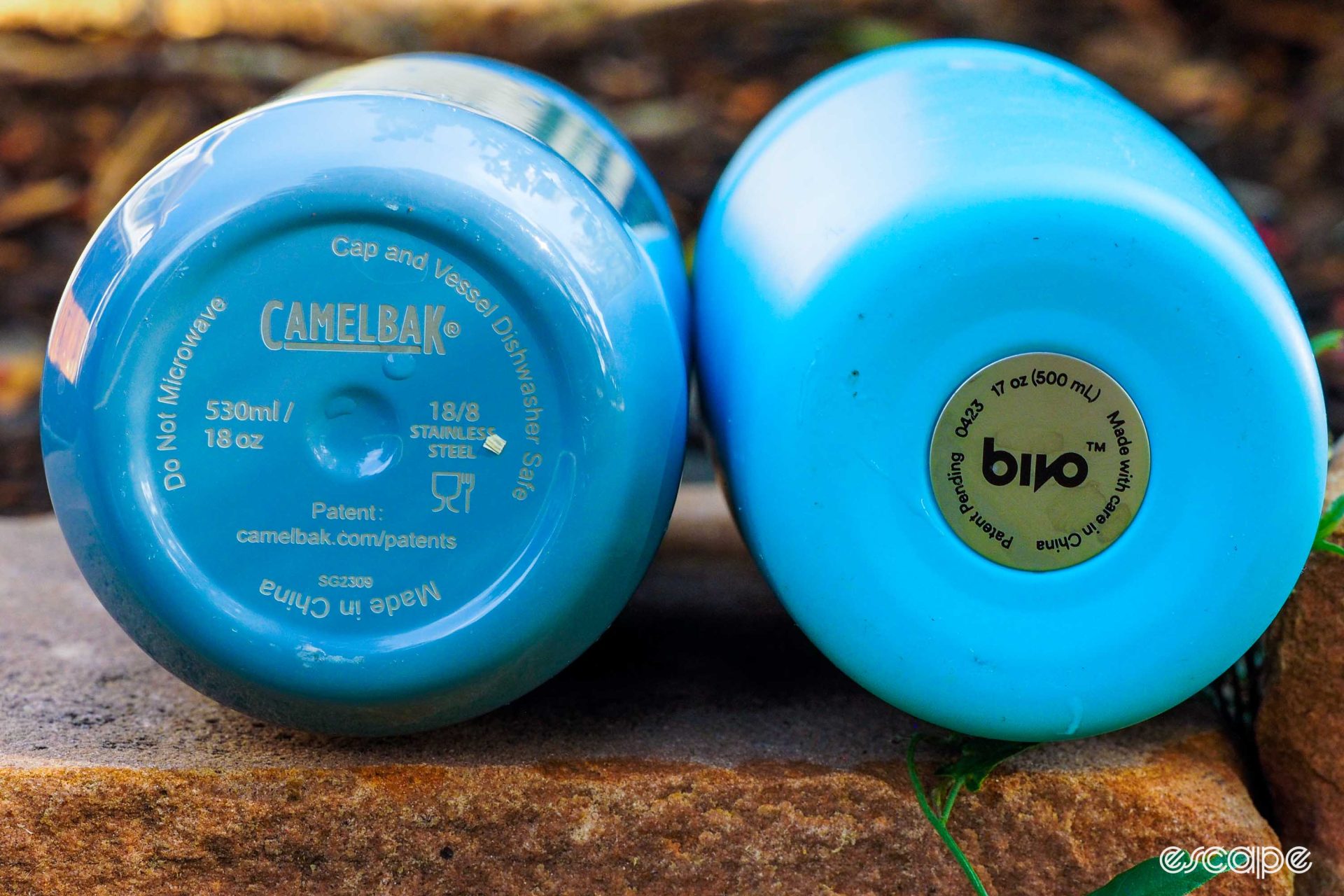
On paper, the Bivo Trio Mini holds the least of the three with an official capacity of just 500 mL – 30 mL less than either of the CamelBak metal bottles. But the Bivo’s actual capacity is 527 mL while the CamelBaks hold 532 mL each so in reality, it’s basically a dead heat. That’s not a lot of fluid regardless, though, so unless your summertime rides trend on the shorter end, I’d opt for the larger sizes whichever one you choose.
For the sake of comparison, a small Specialized Purist has a similar external volume as the small Bivo and CamelBak insulated bottles, but is rated at a much more capacious 650 mL (22 oz). Similarly, the large Purist bottle has roughly the same external dimensions as the large Bivo and CamelBak insulated bottles, but holds way more with an official capacity of 770 mL (26 oz).
The other metric is flow rate.
CamelBak was pretty bold in essentially copying Bivo’s delivery system (which itself is based on those commonly found in toddler sippy cups) almost exactly – at least in concept. Since you can’t squeeze a metal bottle like you can a plastic one, any volume of water that comes out has to be replaced by the same amount of air coming in. All three bottles use a one-way valve in the top connected to a flexible silicone straw inside, so all you have to do is tip the bottles over and slurp away.
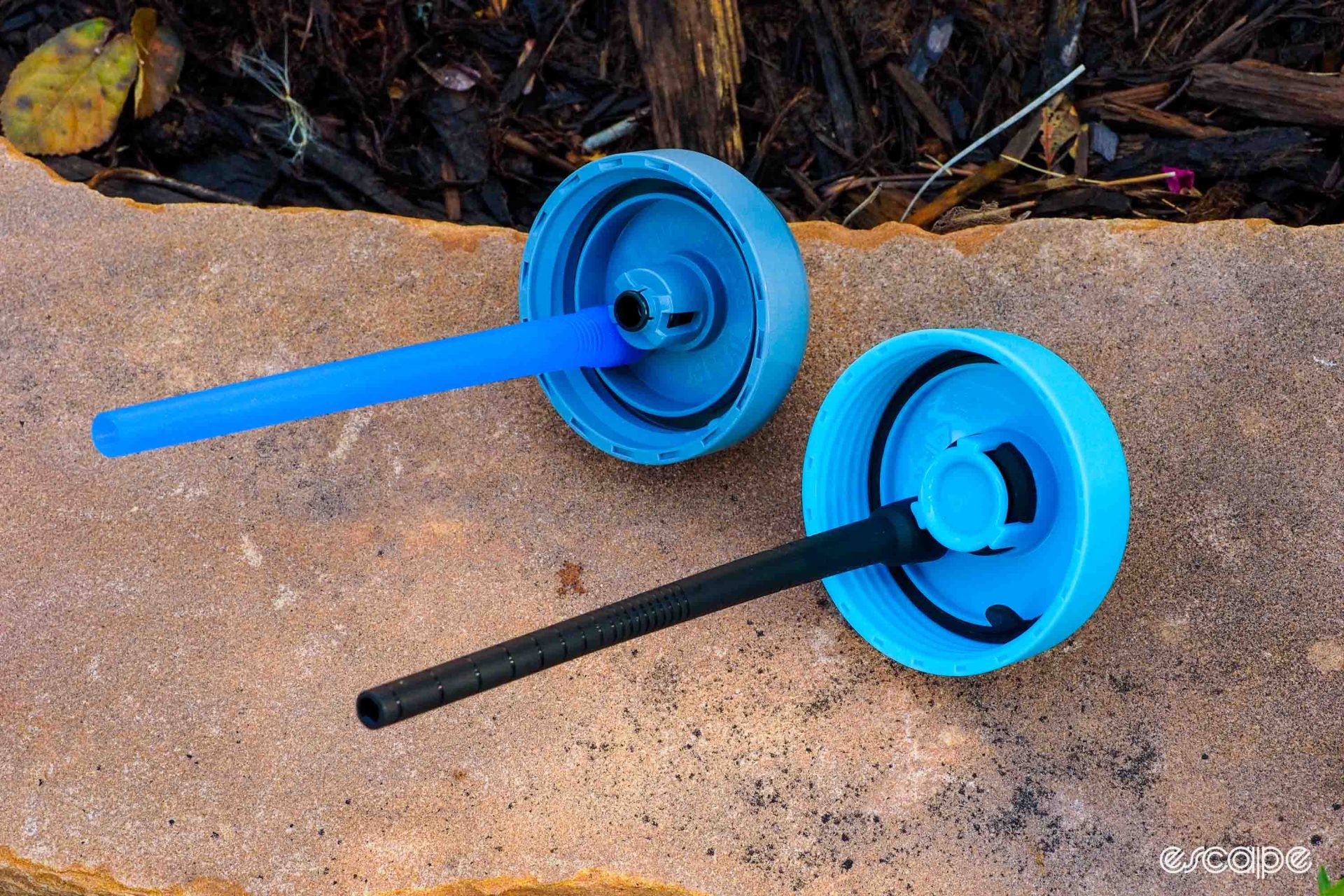
CamelBak may have emulated the idea, but the execution falls slightly short. One of the things I love most about the Bivo is the fast flow rate. When inverted, a full Bivo Trio Mini bottle will completely empty in just nine seconds – faster than many people can swallow.
In contrast, the CamelBak nozzle operates at roughly half speed, with both the Podium Ti and Podium Stainless draining in an identical 18 seconds. It’s not like it takes a lot of suction to get water out of either CamelBak bottle, but on the bike, the Bivo delivers its contents noticeably faster – and when it’s truly blazing hot outside, I want my water right now.
Now weight just a minute
Weight weenies unfortunately might just have to resign themselves to drinking hot water because in addition to reduced volume, another downside to double-walled vacuum-insulated bottles is weight. All that metal adds up, and in no small way.
For reference, a small Specialized Purist bottle tips the scales at 79 g, while a large-sized one is 88 g. As expected, a doubled-walled large Purist insulated plastic bottle is almost twice as heavy at 155 g.
The small Bivo Trio? It’s a hefty 252 g (and keep in mind the reduced volume). The large Bivo Trio is thankfully only slightly heavier at 274 g. The stainless CamelBak Podium is a real porker at 310 g for the small size and 359 g for the bigger one. Meanwhile, the scale is where the Podium Ti really shows its advantage, as the non-ferrous construction makes it the lightest the bunch by a slight margin at 234 g for the small size.
Other considerations
I’m kind of nuts about keeping my bottles clean. They get rinsed and either hand-washed or loaded into the dishwasher immediately after every ride, and they’re never, ever put away even slightly wet (because do you like drinking mold? I don’t). As such, I’m a big fan of bottles that can be completely taken apart so there aren’t any nooks or crannies where microbes can hang out and fester.
In that regard, Bivo has a big advantage here. The nozzle, hose, and seal are all made of the same silicone rubber, and all three are designed to be quickly and easily disassembled for thorough cleaning (and more importantly, drying). After a ride, it’s literally a ten-second process to take the top apart and toss all of the individual bits into the dishwasher.
In contrast, you can remove the hose and rubber tip from the CamelBak bottle, but not the seal. And while it’s nice that the CamelBak top incorporates a much more robust twist-lock seal (like with every Podium bottle), you can’t easily take that assembly apart. Hopefully it gets fully cleaned and dries out after each use? Maybe it does … but maybe it doesn’t.
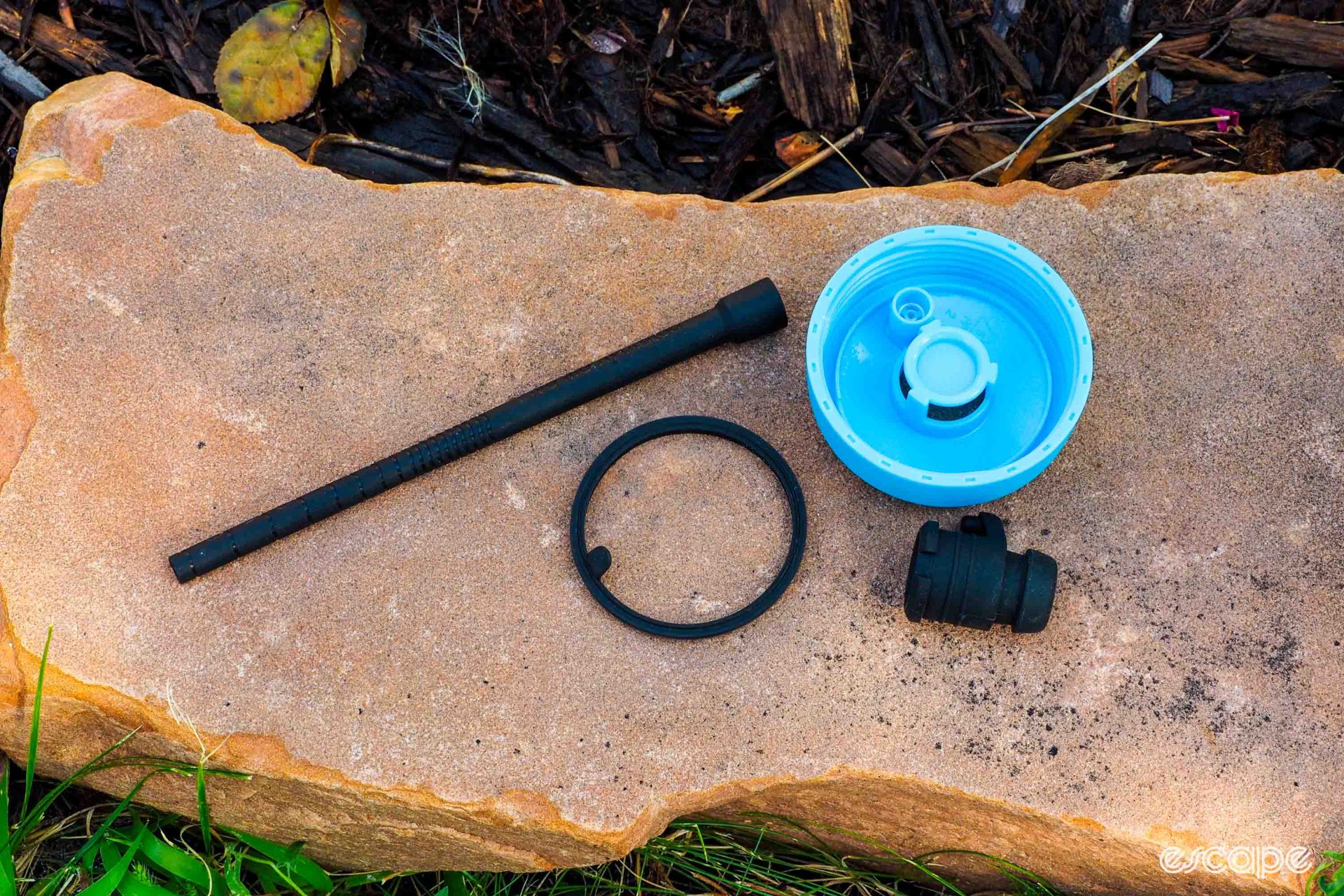
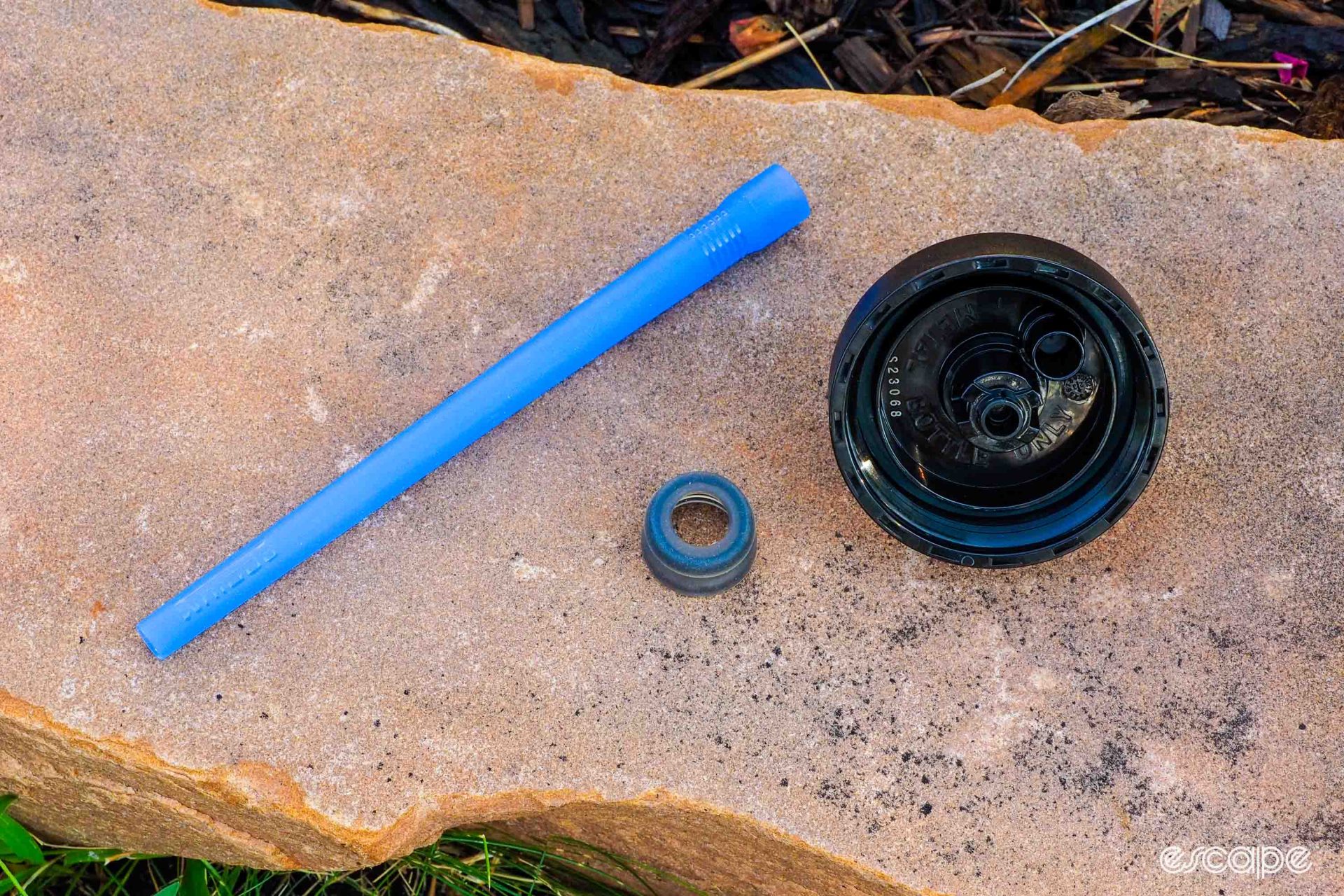
Unfortunately, both brands use open nozzles that can seal the contents from leaking, but are otherwise open to collecting dirt and debris. Neither design is ideal in that respect, but Bivo at least offers a separate mud cap so you don’t accidentally suck down a bunch of cow poo. Eww.
And the winner is …
Ok, so all three of the double-walled metal bottle front runners have similar capacities, they all insulate extremely well, and they’re all pretty darn expensive. Which one would I buy?
My money is on the Bivo Trio.
Although it wasn’t the best in the insulation test, it’s still excellent in that regard (and as I mentioned earlier, that water will be long gone before it heats up, anyway). The flow rate is the best by a wide margin, it’s the easiest to keep clean, it’s priced similarly to the better-insulating stainless CamelBak Podium, and the optional mud cap is a nice add-on if plan on heading off-road, too.
As for the titanium CamelBak Podium insulated bottle, it’s neat, but I just wouldn’t bother as the weight advantage isn’t anywhere near big enough to justify its exorbitant cost. Stick to stainless.
Did I miss anything? Let me know in the comments below, but otherwise, stay cool and hydrated, everyone. Summer hasn’t relinquished its grip on us just yet.
More information can be found at www.drinkbivo.com and www.camelbak.com.
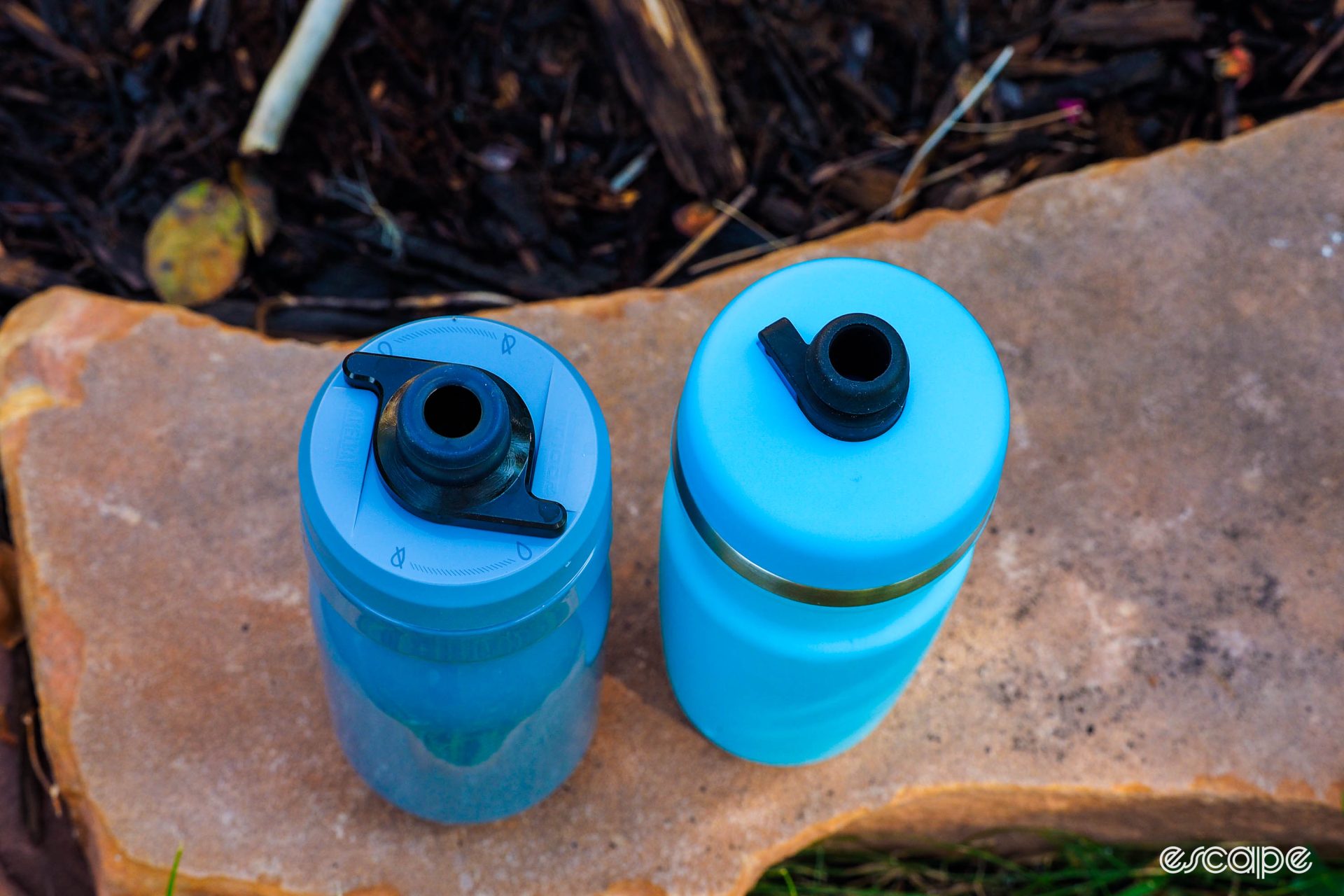
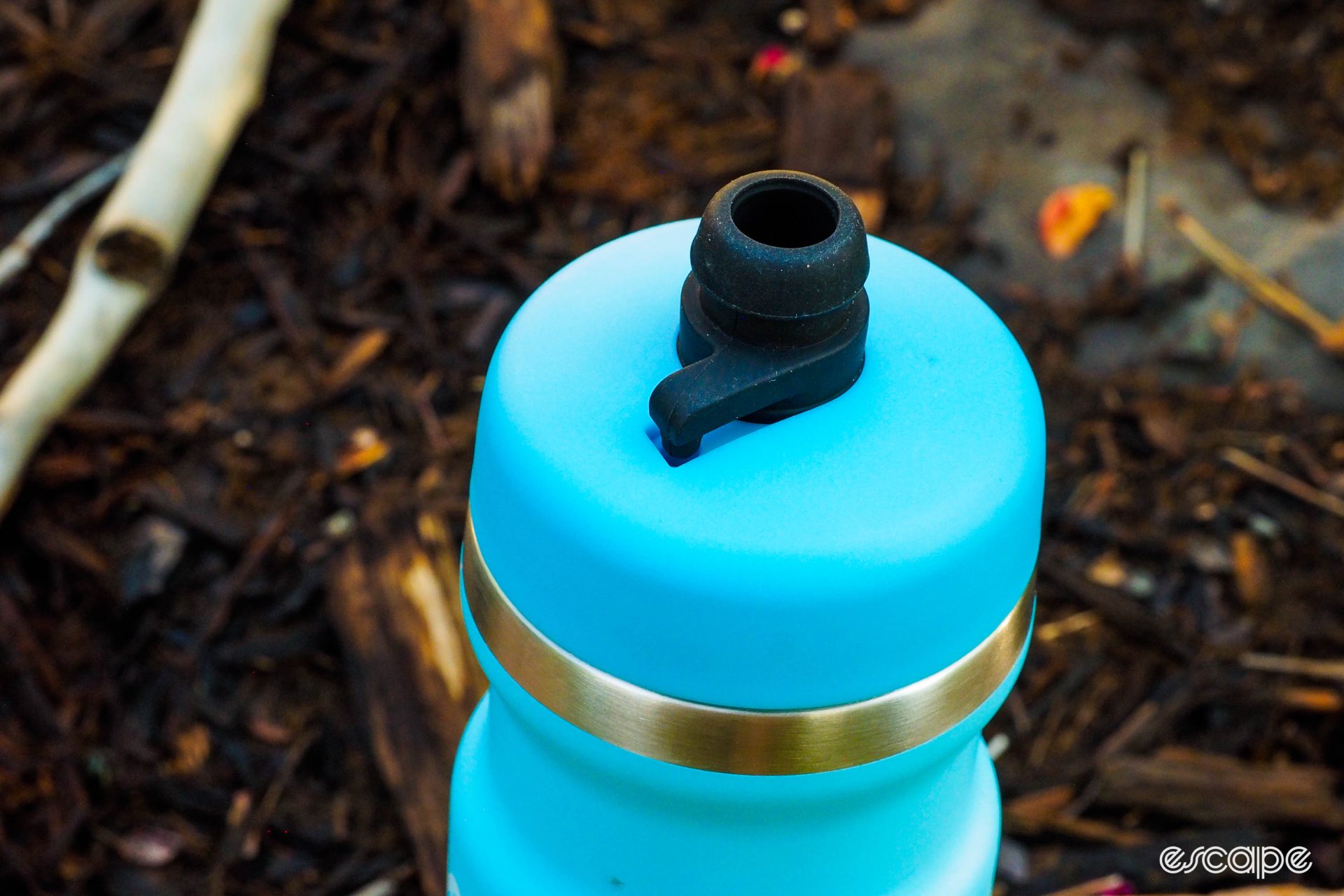
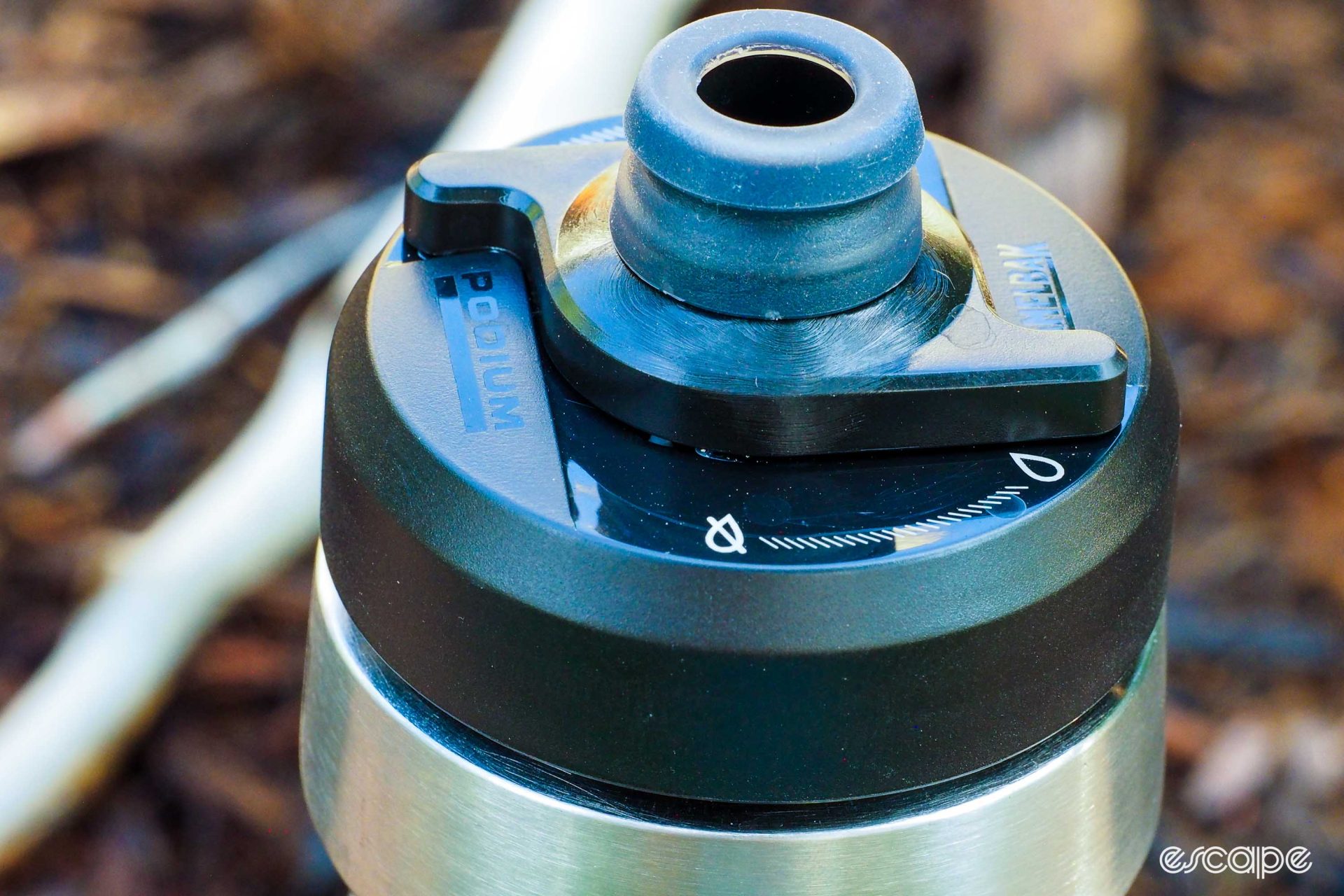
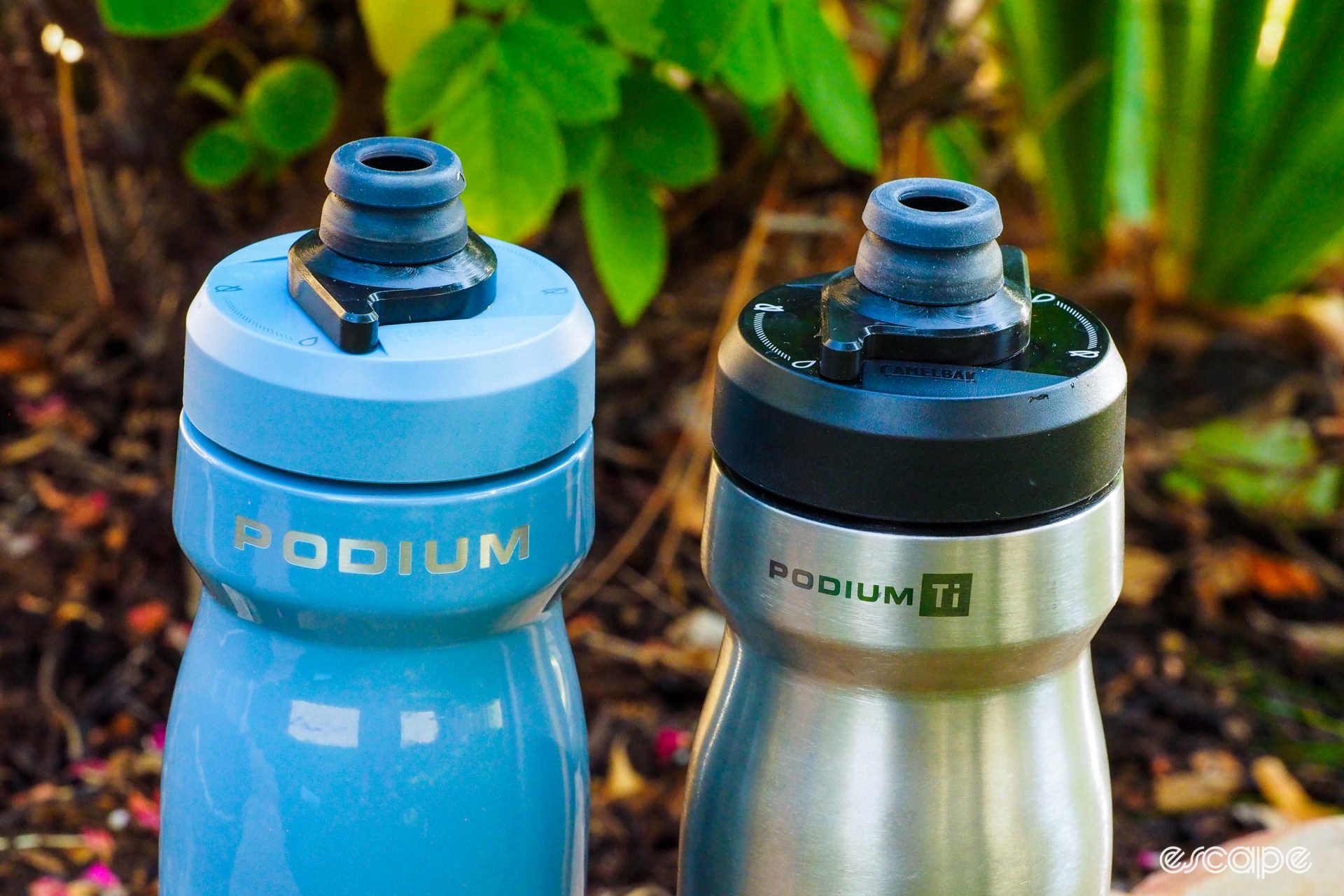
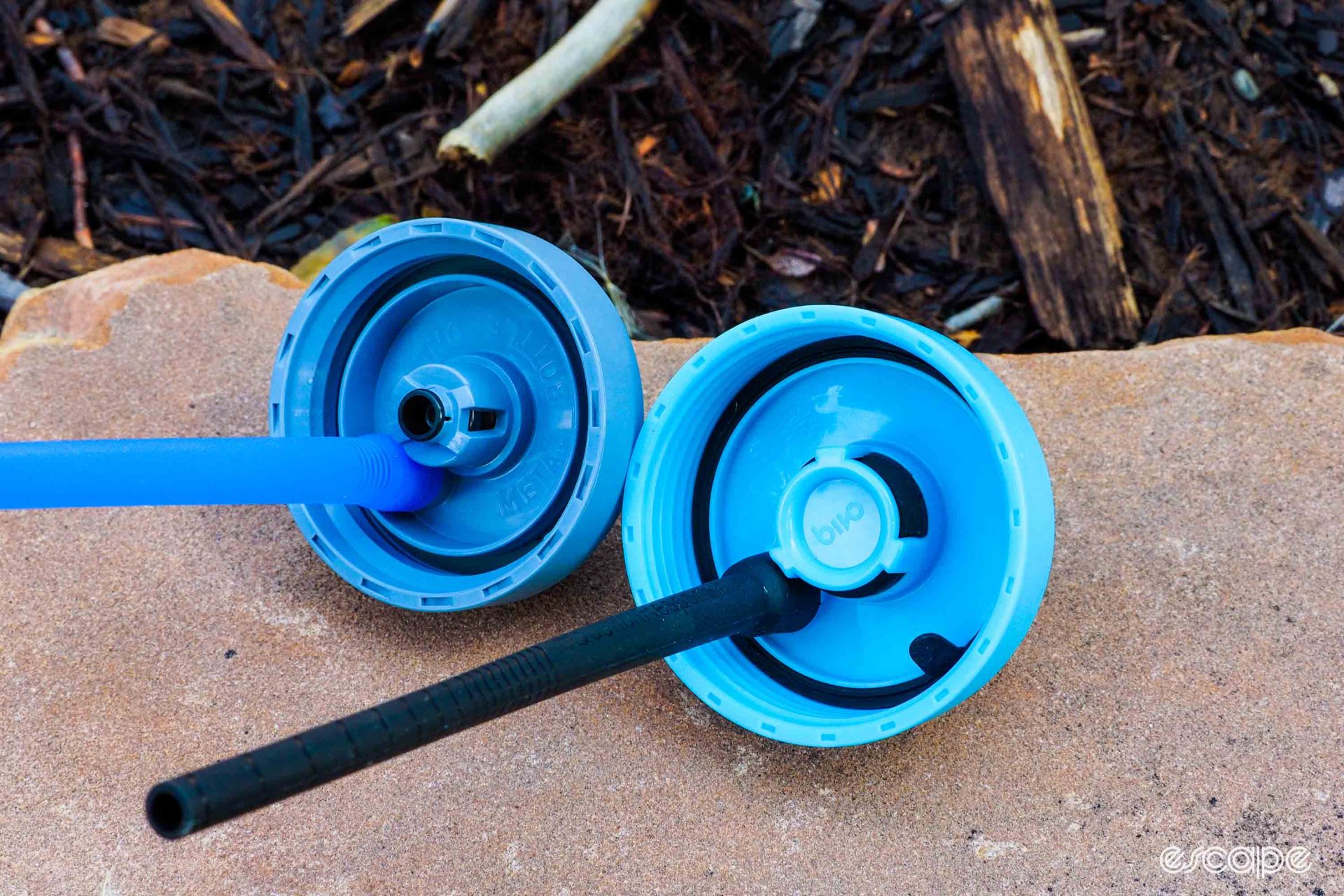
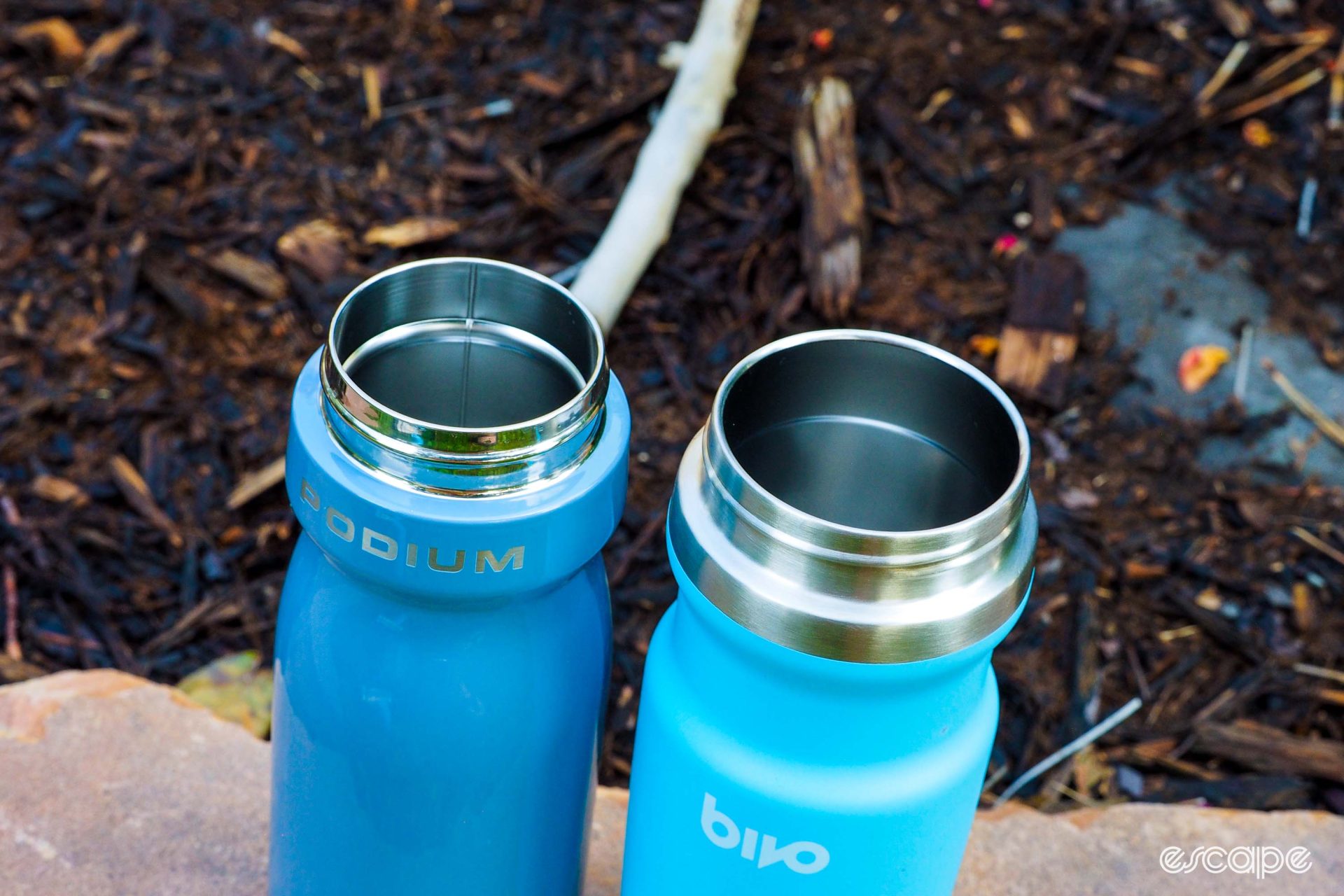
Did we do a good job with this story?

